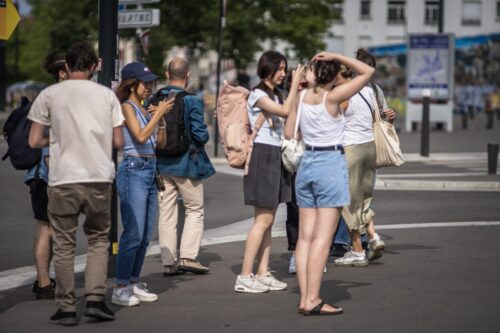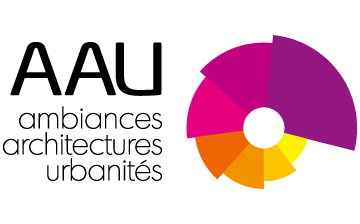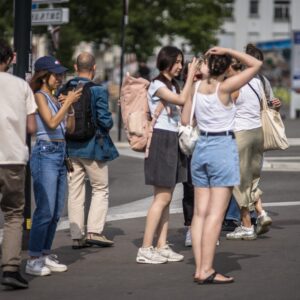Intership topic proposal: Evaluation of the Body Mask Effects on GNSS Receiver for Pedestrian Navigation
Actualité publiée le 27 mars 2023

Team: AAU-CRENAU Laboratory AAU, University Centrale Nantes and Team Geoloc, Department AME Univ. Gustave Eiffel
and co- supervised by the team Geoloc and the team Crenau of AAU Lab.
Problematic
With the continuous development of intelligent objects, new mobility applications, from pedestrian navigation aids to autonomous vehicles, require highly accurate positioning information. Especially for reliability-critical applications, such as guidance for blind people, providing accurate positioning information is essential. Global Navigation Satellite Systems (GNSS) are still the main positioning tools for outdoor localization services. However, it is commonly accepted that urban environments present great challenges to common commercial GNSS receivers. This is because GNSS positioning performances can be severely degraded by obstacles, which lead to multipath and Non-Line-of-Sight (NLOS) reception. It is essential to distinguish the LOS/NLOS receptions in order to process the latter in an appropriate manner and thus improve the GNSS positioning accuracy.
Context
In the current literature, much research work has addressed the problematic of NLOS mitigation for vehicular navigation applications. One of the most efficient techniques is to use a sky-pointing fisheye camera to differentiate between the sky and obstacles. Then LOS/NLOS can be classified by projecting the visible satellites onto the previously obtained sky mask image. However, when the GNSS receiver is positioned on the body of a pedestrian (hand- held or foot-mounted), not only the environmental obstacles (such as buildings, vegetation, etc.) but also the pedestrian’s body can create mask effects, which can potentially degrade the GNSS positioning performances. Very few research works in the state-of-the-art have addressed the body mask effects on GNSS signal reception for pedestrian navigation. The main objective of this internship is to analyze the mask effects of both environments and the pedestrian’s body on a hand-held and a foot-mounted positioning equipment, which aims at improving the GNSS positioning accuracy. This internship is a continuation of a previous one which will lead to a communication in the IEEE ION PLANS 2023 conference
This first internship highlighted the robustness of a fisheye image segmentation method based on deep learning and, in terms of GNSS signal reception reliability, the relevance of a foot-mounted vs. a hand-held positioning device.
Main tasks
This internship consists essentially of simulation work including image processing and integration of multiple data (ephemeris, topographic and altimetric datasets, etc.). Nevertheless, it is planned to carry out – several times during the period – a set of experimental fieldwork aiming at collecting data. In this objective, it will be a question of installing a camera on the top of the target pedestrian positioning equipment named ULISS (Ubiquitous Localization with Inertial Sensors and Satellites), which is developed by the GEOLOC Lab. From the collected datasets, the main tasks of this internship are as follows:
- Reuse the image segmentation solution already implemented to differentiate the sky and obstacles;
- Characterize the body mask effect as a function of the camera position (hand-held or foot mounted) and analyze the shape of the occlusion from the image segmentation (oblong nature, compactness, mask ratio, );
- Reuse the proper projective transformation method already implemented to project the visible satellites from the ephemeris onto the image;
- Reuse the software solution already implemented to analyze the GNSS LOS/NLOS receptions for the hand-held and the foot-mounted positioning equipment. Compare both results to the reference trajectory and draw conclusions regarding the body mask effects;
- Analyze the correlation of GNSS reception quality (SNR, PHAcc, GDoP…) with morphological indicators (SVF, panoptic H/W, panoptic mean H, panoptic mean W, ) derived from an analysis of the urban mockup produced from the topographic database. By exploiting machine learning techniques, it could be interesting to develop a solution capable of predicting, at any point of the open space in the city, from the Topographic Database and the position of the satellite in the sky, its LOS/NLOS classification.
- Propose a method to better take advantage of the LOS/NLOS classification in the navigation filter (such as NLOS exclusion or weighting according to LOS/NLOS, ) and then validate the proposed method by real experimentation.
To apply, please send your CV and note transcripts to:
myriam.servieres(a)ec- nantes.fr, thomas.leduc(a)crenau.archi.fr, ni.zhu(a)univ-eiffel.fr
Download the Internship proposal.
Catégorie : AAU, CRENAU
Tags : Body Mask Effects, Evaluation, Intership topic proposal, Pedestrian

